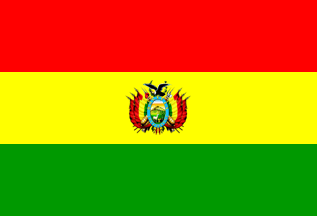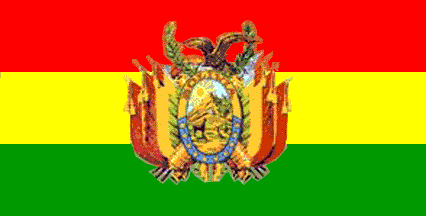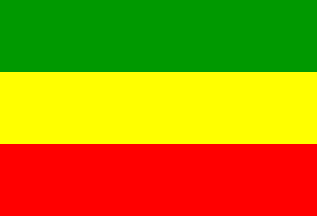
Last modified: 2007-06-09 by antónio martins
Keywords: bolivia | bulibiya | state flag | variation | fertility | bravery | wealth | president | flag | disc (blue) |
Links: FOTW homepage |
search |
disclaimer and copyright |
write us |
mirrors

The Album 2000 [pay00] says:
1. National flag.As far as I am aware, this flag is defined in Decret of 14 July 1888 and has not been changed since (though, possibly there were latter regulations that did not touch this simple flag).2:3
Flag adopted in
1851.10.31,
and confirmed in
1888.07.14.
Jaume Ollé, 01 Jan 1996
The
current
Bolivian flag law was published as a special issue of the Bolivian official
journal: Gaceta Oficial de Bolivia 2630/XLIV (2004.07.19), La
Paz; it shows a large color depiction of the national arms and the title
Simbolos Patrios (= Symbols of the Fatherland). I’m not sure wheather
these new regulations do indeed introduce any changes or just bring toghether
and clarify previously disperse legal provisions and/or costumary
tradition.
António Martins, 19 Aug 2005
Art.
4, point III, of the flag law prescribes the civil flag, which is the
plain triband.
António Martins, 19 Aug 2005
The Law of 5 November 1851 (of which I only have a small extract), the
(Supreme) Decree of President Gregorio Pacheco of 11 July 1888, and the
(Supreme) Decree of 30 July 2004 all place the red stripe
uppermost.
Christopher Southworth, 09 Apr 2006
Art. 3
of the flag law gives the official color shades: Red is PMS 485 CVU, yellow
is PMS Process Yellow, and green is PMS 356 CVU. Red and yellow match both the
images on these pages and the law text illustrations, but the shade of green
not so: While the prescribed PMS value is darker than regular green
(![]() ), the law
text illustrations show a much brighter shade.
), the law
text illustrations show a much brighter shade.
António Martins, 19 Aug 2005
As far as the yellow of the Bolivian tricolour is concerned, I
have no official recommendations, however, an official model of the
Naval Ensign shows the middle stripe to be
Pantone 107C.
Christopher Southworth, 04 Feb 2002
In art. 2
of the flag law, the ratio of the flag is given as 7,5:11, which
is as clumsy as it comes for a flag with three equal-height stripes.
(A much more even fraction to express this ratio is 15:22.) This pretty odd
ratio seems to be a novelty, as all previous sources we heard of mentioned 2:3
instead (which is not very different from 15:22, anyway). The question is, as
said, wheather this ratio prescription indeed indends to introduce a change,
or merely legislates what was previously unregulated…
António Martins, 19 Aug 2005
I also wondered why a regulated size of 15:22, but since there is only
0.034% of flag width in it I would imagine that most flags would actually
be made 2:3?
Christopher Southworth, 20 Aug 2005
Art.
1 of the flag law, mentions the symbolism of the colors, as patriotic
bloodshed, nature’s bounty, and verdure and hope. (Which is
all bogus, as we know.)
António Martins, 19 Aug 2005
In Whitney Smith’s Flags through he Ages and Across the World
[smi75b] the red is said to stand for
the bravery of the Bolivian soldier, green is the fertility of the land
and yellow represents the country’s mineral resources.
Stephan Hurford, 13 Feb 2000
In Webster’s Concise Encyclopedia of Flags, 1985 [mch85a]:
The three horizontal stripes of the Bolivian flag — red, yellow and green — respectively symbolize the gallantry of Bolivian soldiers, the country’s mineral wealth, and the fertility of the land.The meaning of colors on flags is usually given after a flag is adopted; this was probably the case here, as they were derived from earlier flags of Colombia and her liberator, Simon Bolívar
According to [mch85a],
the flag with its present order of stripes was introduced in
1851 but a number of variations
had been used since Bolivia gained independence in
1825.
Jarig Bakker, 02 Jan 2002

The Bolivian coat of arms of
1888 is placed in the middle of the state flag.
Jarig Bakker, 02 Jan 2002
I’ve been in Bolivia in March 2001; the state flag is hardly ever
seen. Even over the presidential palace the plain tricolour
is flown.
Mark Sensen, 03 Jul 2005
Art.
4, point I, of the flag law prescribes the state flag; the image which
illustrates it is very low quality and there is no indication (neither textual
nor pictoric) of the size of the emblem — only that it should be
“centered” on the yellow stripe and showing on both sides
of the flag. (It is also left unsaid whather the embelm is mirrored or rotated
on the flag’s reverse.)
António Martins, 19 Aug 2005
According to a detailed graphic of the arms at an
official
website, their proportions are 13:15 (and apparently
occupying 13/17 the width of the central stripe), plus official Pantone
colours of red 465, Process yellow and green 356.
Christopher Southworth, 02 Aug 2004
The Album 2000 [pay00] have the emblem much larger, about half of the flag hoist. It says:
2. State FlagThe note beside this flag describes that it is also the personal flag for the President of the Republic and and that it is also used in 1:2 variant. What’s the right size of the coat of arms in the state flag, it is prescribed anywhere at all? The book [smi80] indicates the flag use only as2:3

On Bolivian web sites
[f.i., www.bolivian.com/bolivia/bandera.html]
there is a new version of the national flag, which I believe is only for
decorative reasons. It shows the coat-of-arms stretching out over all three
stripes!
Ralf Stelter, 13 Jun 1999
According to an original piece received from the bolivian
embassy in Paris (and a phone call from them), the flag should
normally be in 2:3 ratio, the flag in 1:2 being an alternative
variant.
Armand du Payrat, 28 Sep 1999
This large emblem verson is kind of unofficial, but ceremonial
version used when “it matters”, if I may put it that way.
Željko Heimer, 11 Mar 2001
My sources (real flags and designs from French Embassy in La Paz
and from Bolivian Consulate in Paris) have various sizes of coat of
arms in flag.
Armand du Payrat, 12 Mar 2001
.gif)
[smi80] shows the coat of arms
set in light blue disk of diameter equal to yellow stripe height.
Željko Heimer, 11 Mar 2001
My sources (real flags and designs from French Embassy in La Paz
and from Bolivian Consulate in Paris) concurr to no blue disk.
Armand du Payrat, 12 Mar 2001
Art.
5, point IV, of the flag law, which prescribes the national coat of arms,
includes a provision that «when needed» the it should have a
“pearl blue” background, which may account for this variant
/ error.
António Martins, 19 Aug 2005

The note beside the state flag in the Album
2000 [pay00] describes that it is
also the personal flag for the President of the Republic and and that it
is also used in 1:2 variant.
Željko Heimer, 11 Mar 2001
I’ve been in Bolivia in March 2001; the state flag is hardly ever
seen. Even over the presidential palace the plain tricolour is flown.
Mark Sensen, 03 Jul 2005

A friend of mine whose son is serving as a missionary in Bolivia
said that his son has reported that the red stripe is up only in times
of war. I said that that is more than likely an urban legend.
David Kendall, 27 Jun 2005
Very very fishy. The red stripe is up, according to the
law, yet was at war last time in the 1920ies; even if it
is red on the bottom (i.e., inverted flag)
meaning war, it would be unthinkable to fly the coat of arms upside down (on
the state flag).
António Martins, 03 Jul 2005 and 01 Dec 2006
Probably an urban legend, but possibly based on the
Philippines war flag. I’m sure the father
in question knows whether his son is in the Philippines or Bolivia, but if
it’s a friend-of-a-friend story, the countries could shift.
Dean McGee, 10 Apr 2006
Anything below this line was not added by the editor of this page.